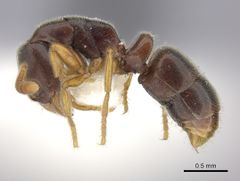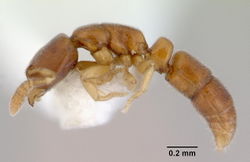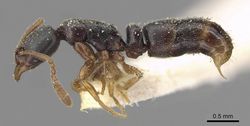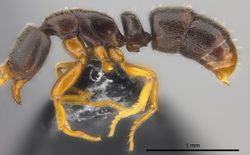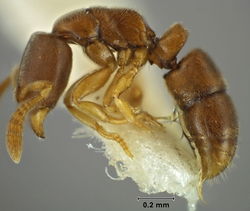Key to Ponera species
This worker key is based on: Taylor, R.W. 1967a. A monographic revision of the ant genus Ponera Latreille (Hymenoptera: Formicidae). Pacific Insects Monograph. 13:1-112.
caveat utilitor - While this key was made close to 50 years ago it does provide some help for many of the more common species and for others that had been described by 1967 as well.
Taylor prefaced his key with these remarks: Based primarily on workers; where applicable queen, male, or larval characters are included. The alate castes are too poorly known to allow presentation of separate keys.
You may also be interested in
1
- An exceptionally large species (HW 0.76-0.85 mm); petiolar node relatively very broad (PNI 92-9 8 ). (NE New Guinea) . . . . . Ponera alpha
- Smaller species (HW less than 0.73 mm); petiolar node narrower (PNI less than 90) . . . . . 2
2
return to couplet #1
- Eyes large, with 9-16 distinct facets; medium size species, HW 0.55-0.62 mm; ranges for CI and SI 80-93, and 86-9 1 respectively . . . . . 3
- Eyes smaller, usually with less than 6 facets; one or more of the relevant dimensions outside the ranges specified above [one species (P. woodwardi) has eyes with 7-11 facets, but it has CI 77-8 1 , SI 98-102] . . . . . 5
3
return to couplet #2
- Larger species (HL 0.70-0.74 mm); head relatively narrow (CI 80-83); mesosoma completely devoid of standing hairs. (Mountains of NE New Guinea) . . . . . Ponera elegantula
- Smaller species (HL 0.60-0.65 mm); with proportionately broad heads (CI 86-93); mesosoma with distinct erect pilosity . . . . . 4
4
return to couplet #3
- Relatively broad-headed species (CI 90-93); petiolar node proportionately narrow (PNI 8 1 -83). (Mountains of NE New Guinea) . . . . . Ponera augusta
- Head relatively narrow (CI 86-88); petiolar node broader (PNI 86-90). (Mountains of C. Borneo) . . . . . Ponera borneensis
5
return to couplet #2
- Relatively large, broad-headed species, with the following combination of characters HW 0.61 -0.70 mm, HL 0.75-0.84 mm, CI 78-98, petiole height 0.50-0.59 mm . . . . . 6
- Usually much smaller species, with a very different array of dimensional ranges; those with HW measurements falling within the above range, have at least two of the other dimensions outside the ranges given . . . . . 8
6
return to couplet #5
- Head relatively broad (CI 86-90); median clypeal tooth represented at most by a low tumosity; PNI values ranging 77-84. (NE New Guinea) . . . . . Ponera xenagos
- Head narrower (CI 78-84); median clypeal tooth usually distinct-if it is vestigial the PNI exceeds 84 . . . . . 7
7
return to couplet #6
- Head relatively broad (CI 83-84); scapes clearly exceeding median occipital border when laid back along head; node relatively narrow (PNI 79-80) (Mindanao, Philippines). . . . . Ponera chapmani
- Head less broad (CI 78-83); scapes slightly but distinctly failing to reach median occipital border; node relatively broad (PNI 84-89). (Honshu, 19 Japan) . . . . . Ponera scabra
8
return to couplet #5
- Head relatively broad, CI 88-95 . . . . . 9
- Head not so broad, CI never exceeding 86, usually much lower . . . . . 12
9
return to couplet #8
- Smaller species (HW 0.47-0.51 mm), PNI values ranging 82-85 . . . . . 10
- Larger species (HW 0.57-0.65 mm), PNI values outside range cited above (higher or lower) . . . . . 11
10
return to couplet #9
- Smaller species (HW 0.47-0. 5 1 mm, HL 0.50-0.54 mm) , with relatively broad head and short scapes (CI 92-95, SI 78-8 1 ). (Negros I., Philippines) . . . . . Ponera oreas
- Known only from unique holotype. Larger species (HW 0.54 mm, HL 0.61 mm), with narrower head and longer scapes (CI 89, SI 83). (Hong Kong) . . . . . Ponera sinensis
11
return to couplet #9
- Petiolar node relatively high and broad (petiole height 0.45-0.48 mm, PNI 85-89); color dark brown, almost black; eyes with 2-3 facets; size slightly larger (HW 0.59-0.65 mm). (NE New Guinea; Cape York, Australia) . . . . . Ponera selenophora
- Petiolar node relatively low and narrow (petiole height 0.41 mm, PNI 73 in unique holotype); color medium reddish brown; eyes with s ingle, very minute facets; HW slightly lower (0.57 mm). (Viti Levu, Fiji) . . . . . Ponera manni
12
return to couplet #8
- Mesometanotal suture not incised on mesosomal dorsum . . . . . 13
- Mesometanotal suture distinctly incised o n mesosomal dorsum . . . . . 22
13
return to couplet #12
- Petiolar node relatively narrow (PNI 65-76); size small (HW 0.30-0.45 mm) . . . . . 14
- Petiolar node relatively broad ( P N I 78-9 1 ); larger species (HW 0.48-0.63 mm, with one exception, P. ciavicornis, HW 0.43-0.47 mm) . . . . . 17
14
return to couplet #13
- Larger species, HW 0.39-0.45 m m. (New Guinea and Samoan Is.) . . . . . Ponera tenuis
- Much smaller species, HW 0.30-0.34 mm . . . . . 15
15
return to couplet #14
- Slightly smaller species (HW 0.30-0.32 mm) , with proportionately short scapes (SI 78-83); petiolar node narrow (PNI 61-65). (E. New Guinea) . . . . . Ponera szaboi
- Slightly larger species (HW 0.32-0.34 mm) , with proportionately long scapes (SI 88-94); petiolar node broader (PNI 72-86) . . . . . 16
16
return to couplet #15
- Lateral surfaces of mesosoma very feebly shagreened to smooth and shining; petiolar node relatively low, its height in the unique holotype 0.25 mm, about the same as the pronotum width; the SI 88. (NE New Guinea) . . . . . Ponera petila
- Lateral surfaces of mesosoma all moderately shagreened, and opaque; petiolar node relatively high, its height in the single measurable specimen 0.29 mm, or slightly more than the pronotum width; the SI 94. (SE New Guinea) . . . . . Ponera szentivanyi
17
return to couplet #13
- Moderately small species (HW 0.43-0.47 mm); mesosomal dorsum in profile completely lacking erect hairs. (New Guinea and E. Melanesia) . . . . . Ponera clavicornis
- Larger species (HW 0.50-0.63 mm); mesosomal dorsum in profile with abundant
standing hairs . . . . . 18
18
return to couplet #17
- Scapes exceptionally long, exceeding median occipital border by 1 to 1.5 X their maximum thickness (SI 98-102). (Upolu, Samoan Is.) . . . . . Ponera woodwardi
- Scapes usually approximately contiguous with median occipital border, rarely clearly xceeding it, SI always less than 92, usually considerably so . . . . . 19
19
return to couplet #18
- Petiolar node relatively broad (PNI 84-9 1 ) . . . . . 20
- Petiolar node proportionately narrow (PNI 78-82) . . . . . 21
20
return to couplet #19
- Head relatively broad, petiolar node relatively narrow ( C I 84-86, P N I 84-85). (Malaya) . . . . . Ponera taipingensis
- Head proportionately narrow, node relatively broad (CI 81-83, PNI 88-91). (Fiji Is.) . . . . . Ponera colaensis
21
return to couplet #19
- Slightly smaller species (HW 0.48-0.50 mm, HL 0.60-0.62 mm) , lacking a distinct median clypeal tooth. (New Guinea) . . . . . Ponera syscena
- Slightly larger species (HW 0.5 1 -0.58 mm, HL 0.62-0.70 mm) , with a distinct strong acute median clypeal tooth. (Upolu, Samoa) . . . . . Ponera loi
22
return to couplet #12
- Smaller species (HW usually less than 0.40 mm, HL less than 0.50 mm-one Japanese and Oriental species with HW 0.42-0.50 mm, and HL 0.53-0.63 mm). Larvae, when known, with 3 pairs of dorsal glutinous tubercles; male palpal formula 4:2 or 2:2 . . . . . 23
- Larger species (HW 0.50-0.63 mm, HL 0.64-0.77); larvae with 4 pairs of glutinous tubercles on abdominal dorsum; males with 5:3 palpal formula. (Europe and E North America) . . . . . 27
23
return to couplet #22
- Antennal funiculus with an indistinctly to distinctly differentiated 5-segmented club; HW 0.32-0.50 mm . . . . . 24
- Antennal funiculus with a distinctly 4-segmented club; HW 0.36-0.41 mm . . . . . 26
24
return to couplet #23
- Size larger (HW 0.42-0.50 mm, HL 0.53-0.63 mm); median clypeal tooth present in some populations. (Japan, Malaya and Java) . . . . . Ponera japonica
- Size smaller (HW 0.32-0.40 mm, HL 0.42-0.50 mm); median clypeal tooth never developed . . . . . 25
25
return to couplet #24
- Larger species (HW 0.36-0.40 mm); head relatively broad (CI 78-84). (Java, E. Melanesia, Samoa) . . . . . Ponera incerta
- Smaller species (HW 0.32-0.33 mm); head relatively narrow (CI 76-78). (Samoa and Hawaii) . . . . . Ponera swezeyi
26
return to couplet #23
- Either the HW is 0.35 mm or less, or the CI is 79 or greater, or both. Where neither of these characters is shown the LPI is within the range 52-57. (SE United States-probably introduced) . . . . . Ponera exotica
- Either the HW is 0.42 mm or greater, or the CI is 76 or less, or both. Where neither character is shown the LPI range is 59-67. (E. Australia, New Zealand, Norfork I., New Caledonia) . . . . . Ponera leae
27
return to couplet #22
- Disc of pronotum moderately shining, with a scattering of fine point-punctures, spaced at intervals of 2-3 X their average diameter; petiolar node of queen relatively narrow (PNI 63-66). (Europe, NW Africa, Middle East) . . . . . Ponera coarctata
- Disc of pronotum subopaque, with a close cover of moderately coarse punctures about 0.005 mm in diameter, separated by distances equal to about 0.5 X their average diameter; petiolar node of queen much broader (PNI 76-80). (E North America) . . . . . Ponera pennsylvanica



